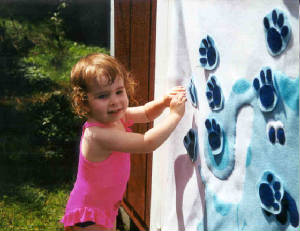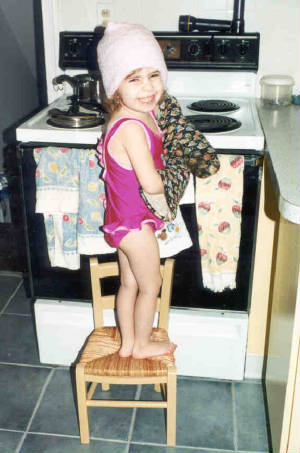|
To Diagnose or Not to Diagnose?
That was the question for a long time. At first I thought hypotonia was a diagnosis. But over time I have
learned that, although some doctors will hand it out like a diagnosis, it is merely a symptom. I was led to believe
it was a mild condition that would resolve itself and PT wouldn't be bad, but wasn't really necessary in the end. For
some children with hypotonia this very well may be true. But for Julie, it has not been. I honestly don't know
where she would be without the PT and the SIOT she has been getting, especially in the last year.

|
| Julie plays "put the pawprint on Blue" at her second birthday party. |
The neurologist Julie sees at Children's Hospital of Philadelphia (CHOP) is a pediatric neuromuscular specialist.
We were lucky that, when we called to see a neurologist when Julie was 2.5, the appointment clerk in neurology set us up with
Dr. Finkel. Not all neurologists are expert enough with neuromuscular problems to be helpful and Dr. Finkel, it seems,
is among the best. Our visit when Julie was 2.6 was an education, to say the least. Julie was NOT at all happy
to be there and cried and fussed angrily through much of the appointment. Dr. Finkel was great with her, though, and
was terrific with us as well. He examined Julie playfully and thoroughly and looked over our older daughter Robin and
us as well. He measured all of our heads to see if Julie's 95%ile head was a family trait or unique...it seems that
I have a merely average sized head, but my husband and older daughter are with Julie and the 95% head size! He reassured
us that although Julie was clearly hypotonic and experiencing motor delays, that her situation seemed mild and that he sees
at least a few children "just like Julie" each week. We pressed him for some idea of what might be going on and he mentioned
the possibility of "benign congenital hypotonia", "benign familial macrocephaly", and a mild congenital myopathy such as Bethlem
Myopathy. He did want to order bloodwork to rule out anything really scary and anything that is treatable, but was not
too excited to do more. More meant an MRI, an EMG and a muscle biopsy and we were not willing to put her through such
invasive and anesthesia requiring tests at that point. He suggested seeing how the bloodwork came back and then following
Julie for the next six months. We agreed.

|
| Julie at 10:50am every morning of preschool at age two needing a rest with her Blankie. |
Fortunately, all of Julie's bloodwork came back normal. We had a brief scare with a suspicious pyruvate level,
but it was normal upon retest. It seems that a lot of these tests are difficult to draw and read accurately, so any
abnormal blood work on a hypotonic child should be repeated at least once before any conclusions are drawn. Julie continued
to make slow but steady progress with PT and we went back to see Dr. Finkel after she turned three. Dr. Finkel was pleased
with her progress, but said that overall he felt that she was not where he would like to see a child with hypotonia at age
three. He was chiefly concerned with her head lag and mentioned that he would really like to see that gone by age three
in a hypotonic child. However, he was still not overly concerned and again mentioned an MRI and a muscle biopsy as the
next step but was in no hurry to do them. He did mention that for some kids like Julie, a supplement called l-carnitine
could be useful. He said that Julie's blood test for carnitine had come back normal, but that it did not indicate what
was going on with carnitine in the muscle. We were very unsure of giving Julie anything without a diagnosis at that
point, so we decided to think about it.
That was when my own research started in earnest. I was upset at Dr. Finkel's suggestions that Julie
was not where he'd like to see a three year old. So with my new cable modem, I set out on the internet looking
for clues. I discovered the iVillage/ParentsPlace Child Hypotonia message board and suddenly a whole world of help and
support opened up to me!
Click here to visit the Child Hypotonia Board
One important thing I learned from the Child Hypotonia board was that the carnitine supplements might help and if they
did not, they would not hurt her. So I called Dr. Finkel that fall and asked for the prescription. I know now
that it was his suspicision that Julie may have a congenital myopathy that led him to suggest carnitine supplements, but at
the time I was just willing to try anything to help Julie, especially with her poor stamina.
I also discovered the book "Raising a Child with a Neuromuscular Disorder" by Charlotte Thompson, MD (I got a copy from
Amazon.com). This book is full of practical advice on helping and managing a child with everything from Duchenne's Muscular
Dystrophy to undiagnosed hypotonia. The chapter explaining the many diagnoses was most helpful of all. I poured
over it, circling and underlining anything that could possibly apply to Julie. Most of what I underlined, interestingly
enough, was under congenital myopathies and metabolic myopathies.
|
 |
|
|
 |
 |
 |
 |
 |
|
 |
 |
 |
 |
 |
 |
|
At three and a half, Dr. Finkel was still pleased with Julie's progress and felt that carnitine was helping. However,
we told him that Julie had had the flu in January and we noticed that it took a full month for her to recover her stamina
once she was over the flu. He said that "caught his attention" and spoke with more certainty about the possibility of
a congenital myopathy. I brought my Dr. Thompson book with me and showed him the diagnoses that I had underlined.
He said that Julie did not "fit the picture" of a child with a metabolic myopathy, but that I was right in that a congenital
myopathy was a possibility. We discussed what going ahead with testing would mean and he said that a muscle biopsy was
the test to do, but we also discussed that even with a definitive diagnosis of myopathy, that we would do nothing different
in terms of caring for Julie. We would still give her the carnitine, we would still participate in PT and SIOT, etc.
We made another six month follow up appointment, reasonably content not to know for certain. The one monkey wrench in
all of this, though, was that Dr. Finkel noticed that Julie's skin was somewhat stretchy. He suggested we see a geneticist
to discuss the possibility of a connective tissue disorder, namely Ehlers-Danlos Syndrome.
In the meantime, I started researching myopathies in earnest. My husband is an internist and he knows enough about
myopathies to know that they are pretty rare and he thought they were more severe in their presentation, so he was very doubtful
that Julie could have one. I wanted more information, though, so I found a wonderful email group through yahoo for people
with myopathies. Some members are affected adults, and some are parents of affected children. They have been so
helpful and supportive--I can't begin to say how much. I discovered that the presentation of a myopathy can vary greatly
from person to person and from myopathy to myopathy and that Julie did compare to a number of children in the group.
A month after Julie turned four, we saw the geneticist. Dr. Kaplan is regarded as one of few experts in pediatric
EDS in the country so we were hopeful that she could give us a definitive answer. The trouble with diagnosing EDS, though,
is that it can only be diagnosed through clinical exam and family history. There is no lab test or medical study to
aid in the diagnosis of the kind of EDS that Julie was suspected of having. After taking a history and examining
Julie and both of us, Dr. Kaplan announced that Mark and Julie both had the hypermobility type of EDS. We were quite
surprised as we were expecting her to rule out EDS. We pressed her on Julie's lack of scarring and bruising, Mark's
lack of bruising and only two scars, and the fact that neither of them had ever had a dislocation. She said the hyperflexibility
of both Julie and Mark's skin and joints and two of Mark's yucky looking scars were enough to make the diagnosis.
Still dubious, we asked what made Julie's situation more likely to be EDS than a myopathy. Her answer was that
Julie had too much "muscle bulk" to have a myopathy.
Needless to say, I threw myself into EDS research after that. There is not a lot of information on the internet,
but what I did find did not make it any clearer that Julie had EDS. I wondered if I was in denial about her diagnosis,
but decided that it was not denial, but rather suspicion that the diagnosis was in error that was driving me.
Two weeks later, we had our follow up with Dr. Finkel, the neurologist. We told him of our visit with Dr. Kaplan
and he was not at all in agreement with her. He was "more certain than ever" that Julie has some kind of myopathy.
We asked why a myopathy and not EDS and he said that Julie's muscle bulk was not the issue, but rather that she still had
head lag at age four and that it took her two and a half years between learning to walk and learning to run. He added
that, in his experience, once a child with EDS can walk, they typically run within a few months. For the first time,
Dr. Finkel encouraged us to consider a muscle biopsy. The wonderful doctor that he is, he was willing to go either way
with us and placed the decision fully on our shoulders. However, there was something different in his manner this visit
as compared to the previous three. After following Julie for a year and a half, he seemed more certain that a muscle
biopsy would be revealing. He also did not downplay the idea this time as he had in the past. His words did not
say "do the biopsy" but his other cues seemed to say that we should seriously consider it. And consider it we did.

|
| This is silly Julie wearing a bathingsuit and winter hat around the house in January, 2001, age 3.5! |
|
 |
|
|
|

